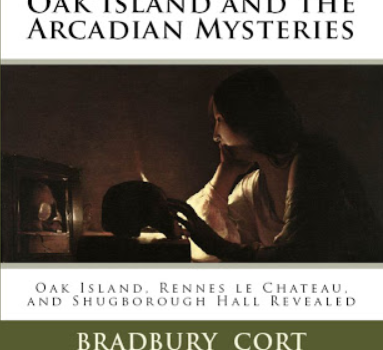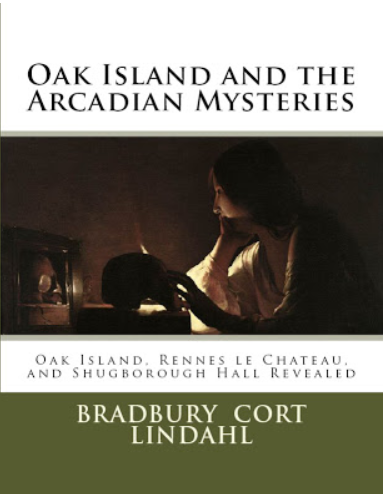
Cort Lindahl actively explores the many mysteries around the world and offers unique perspectives and theories on how they could be seemingly connected. Through his research he has uncovered tantalizing details which might change history as we commonly know it today.
His studies in Art History, Archaeology, and Geography allows him the ability to see answers to mysteries others of single expertise might overlook. He is not hesitant to question those things thought unsolvable or lost to history, and he combines his areas of knowledge to discover possibilities. He shares many of his findings in the numerous books he has published. (Available on Amazon)
Some of you surely recognize him. He was a guest on History’s popular show The Curse of Oak Island, and he, along with his brother, and Justin Cannady, offered one of the favored theories for the Oak Island Mystery. It involved the Founding Fathers of the United States and was recently ranked number 1. Join me as we ask Cort about this and more! Enjoy!
Six Questions with Cort:
- 1Q) Thanks so much for providing MW this opportunity to learn more about your fascinating work. First I have to ask about Oak Island. For those who might have missed your appearance on History’s Curse of Oak Island show, you offered a theory involving the Founding Fathers of the USA. Can you share a bit more about this? How exciting!
Of course! In the colonial era, Nova Scotia was a colony just like the colonies that would become the United States. Prior to the revolution, the English offered land to settlers from the other colonies to come settle in Nova Scotia. This began in about 1710. Many families, like the Longfellow family of Maine, related to the famous poet, settled in Nova Scotia. When the American Revolution began, many of these former American colonists came and fought with the Continental Army. After the war they were allowed to retain their lands in British controlled Nova Scotia. This in part lent to a movement to make Nova Scotia part of the United States that lasted until the end of the nineteenth century.
Additionally, the life of Continental Army General William Alexander may also give us some clues as to the involvement of the founding fathers in the Oak Island Treasure Legend. Alexander was of descent from the brother of the original Baron of Nova Scotia and Earl of Stirling William Alexander. Prior to the Revolution the American colonist from New York and New Jersey, William Alexander returned to Scotland and was awarded these titles by the Scottish peerage. Of course, for political reasons the English Parliament did not recognize him possessing these titles. Despite that, Alexander was always known as “Lord Stirling” in America.
The English would not award these titles to him as they knew this could then extend to a kind of ownership of Nova Scotia. It is also important to note that the original Baron of Nova Scotia, also William Alexander, had amended Philip Sidney’s “Arcadia” somewhere near the date of 1620 (The original had been first published in 1583 by Sir Philip Sidney). He included a new chapter that seemed to tie together parts of the story that were vague or ill defined. The original Baron of Nova Scotia was a courtier and close advisor to both Kings Charles I and II during his life. He was an accomplished author who is among the many candidates people speculate as having been the real authors of the works of Shakespeare. So here we see the Baron of Nova Scotia amending a work entitled “Arcadia” which matches the French name for Nova Scotia in “Acadia.” Acadia is French for Arcadia.
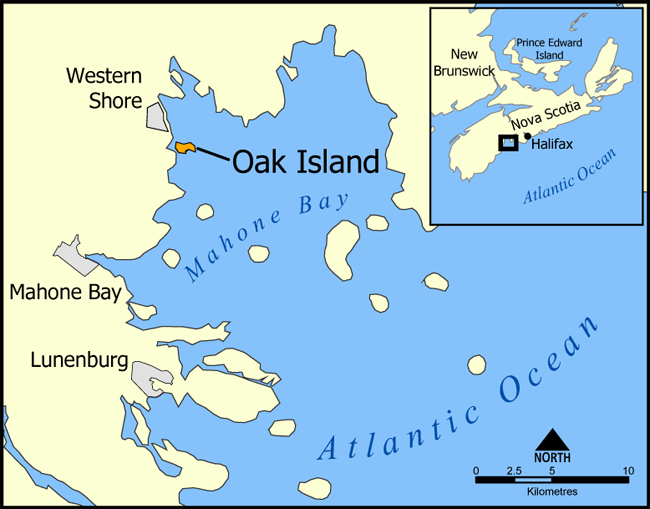
Nova Scotia had in effect been created by General Alexander’s forebear and was also created under the auspices of the exiled kings of England, Ireland, and Scotland i.e. the Stewart family prior to their exile. Their followers were known as Cavaliers which would later be referred to as Jacobites. Over the years, the Jacobites attempted to invade Scotland and England more than once resulting in people from the losing side being exiled in the American Colonies. This resulted in a great deal of Jacobite influence in the creation of the United States that has been somewhat overlooked in the common history. This relates to Oak Island given the possibility that the Jacobites used it as a repository for funds that may have been left over from their revolts in Scotland that could then be used in the American Revolution.
The Jacobites set their sights on America since they found it impossible to regain their lost crowns in what was now the United Kingdom. This value would also apply to any valued symbolic relics or documents that may have been stored at Oak Island. It is also entirely possible that relics associated with deposed kings Charles I and II were also hidden at Oak Island. This could include any number of Christian relics and documents associated with the reigns of these two fallen kings. These things in fact may have been later moved to Williamsburg thus spawning the Legend of the Bruton Vault.
- 2Q) In your book, Oak Island and the Arcadian Mysteries, you delve into more detail about links leading to the Money Pit on Oak Island. The similarities to Sidney’s Arcadia to the story of Oak Island is uncanny. Have you made any further developments on these connections? Or will you share some of the powerful pieces that suggest they are one and the same?
Information not included in the book includes the fact that Philip Sidney was actually awarded a large portion of what was then termed “Norumbega” by Sir Humphry Gilbert who had claimed it in 1583. Gilbert had claimed the region from St. John’s Newfoundland at that time. Of course, Norumbega includes what would become Nova Scotia including Oak Island. Norumbega as described, also extended as far south as Long Island.
To me it is obvious that certain authors of fiction have included real information in their writing. In addition, others may have used imagery from books such as Sidney’s to create real clues as to lost treasures or relics. Other possibilities for this may also include instilling historical facts into a narrative that may have later been overlooked or not emphasized due to political reasons of hiding the truth. So some of the treasures we all are interested in are also a way for the “losers” in any conflict to make sure their legacies are not forgotten via a sort of mystery school technique. This is somewhat similar to the many treasure hunts that your readers are interested in such as the Forrest Fenn Treasure.
I am now in the process of compiling information that shows where Sidney gained his influences, and amazingly, I have found a source of medieval literature that also contains a story strikingly similar to the Oak Island folklore that Sidney is noted as being influenced by. Sidney was also close friends with Sir Francis Drake who may have played a role in the hiding of real treasure in the manner Sidney suggests in his book “Arcadia.”
- 3Q) During your research, what are some of the most surprising facts you have found? Was there any one discovery you were particularly shocked about?
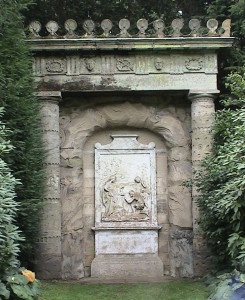
The day I found the Oak Island story in Sidney’s “Arcadia” was likely the most shocking discovery. I felt as if I were a character in an Alfred Hitchcock movie! Amazingly, I was led to this discovery by examining the theme of Arcadia at Shugborough Hall and the Shepherd’s Monument in England as well as Henry Lincoln’s examination of the mystery of Rennes le Chateau in France. These are among what I term the “Arcadian Mysteries.” Through time it is important to note the influence of literary and artist’s guilds in these mysteries and political movements.
After that I began to see other connections to this theme in relation to legends similar to Oak Island. For instance, the Legend of the Bruton Vault in Williamsburg contains many of the same overtones and may even represent a place where important relics, which may have been once stored at Oak Island. They may have been moved because Nova Scotia became a more dangerous place to hide such things. Amazingly, my studies of Arcadia tied into the Axis Mundi as “Arcadia” is a hidden reference to navigation and the Pole star sometimes referred to as the Stella Maris or Star of Mary. Portions of Virginia are also referred to as Arcadia on old maps.
Other treasure legends such as the Beale Treasure also seem to include many of the same families and literary overtones included in the older stories as well. I also believe that Edgar Allan Poe had an influence or involvement in promoting these older stories during his life. Poe even had family relations in Nova Scotia that had been given land there earlier in history, just as the Longfellow family had. I have also noted the influence and involvement of Henry Wadsworth Longfellow in many of these stories, as well including the Newport Tower, Cremona Document, and Kensington Rune. I recently re-read Jules Verne’s “Journey to the Center of the Earth” and that novel’s influence on the Kensington Rune legend is quite obvious. Other authors and artists, such as Samuel Morse and James Fennimore Cooper, were also involved in these activities in my opinion. Note “Coopers Treasure” being of interest to us all! Many of these men were also members of the Society of the Cincinnati.
- 4Q) In one of your previous books, Axis Mundi, you demonstrate how many historical sites connect geometrically to a central axis. Will you share more of your findings or study on this phenomenon?
I do believe that in only certain cases a kind of treasure or Pirate’s map is suggested by using structures like the Newport Tower and octagonal Powder Magazine in Colonial Williamsburg. I believe both of those towers were built as axes mundi. This tradition actually leads us back to Constantine the Great and the four octagonal structures he created that I believe in part were based on the Tower of the Winds of Athens. These structures were meant to define a Prime Meridian and in association a place from which to measure to spatially define the domain of a given ruler. If something important is hidden it is measured in relation to one of these towers which comprise the central axis from which to measure, much like what we see in the fictional portrayal of a Pirate’s map by later writers of fiction.
A later appreciation of this phenomena is given on many English estates of the eighteenth century. In fact, I was led to the Shepherds Monument at Shugborough Hall and all it revealed about Arcadia, only because the estate also includes a copy of the Tower of the Winds of Athens. I also believe that the later Cavalier and Jacobite movements in America used and created towers like the Newport Tower and Powder Magazine in Williamsburg in the same manner, and in fact, these two American towers pre-date the ones on the English estates. As part of this study, my conclusion that the Newport Tower was built in this tradition points to the fact it was indeed built by Benedict Arnold the elder as a memento mori to beheaded king Charles I. The Shepherds Monument at Shugborough is also a memento mori to Charles I leading us to my conclusions about Oak Island as well.
- 5Q) It seems incredible that so many mysteries, which are seemingly and often thought separate, can be related in some way. When did you first discover these overlapping clues and what were your first thoughts about them? Could you believe it?
At first, of course, I had a great deal of disbelief when I realized that some of these legendary stories were indeed connected to each other as in the movie “National Treasure.” I think their “legendary” status is a kind of tip off that they could be related to each other in retrospect. Some of the memory of places like Oak Island seem to have been maintained over a great span of time for a specific purpose. Given that, there are plenty of treasures out there that don’t conform to this template that are indeed real.
Given this, it is interesting that even the Knights of the Golden Circle of the Confederacy used these very techniques to hide things during the Civil War era. Many KGC members in fact came from the legacy of the Cavaliers and Jacobites that I mentioned earlier. So it is no surprise they were privy to this technique. It is important to note here the importance of appreciating how much earlier Americans valued their extended family and history. These extended families also had a propensity to also value each other in business terms to create the early version of industrial empires in America.
The treasures I see being connected via common groups and families are Oak Island, The Newport Tower, Cremona Document, Bruton Vault of Williamsburg, and Beale Treasure, as well as other “hidden history” subjects like the Kensington Rune and “Templars” and Vikings in America. I am working on one now that has not been revealed to the public yet that does involve the octagonal structures created by Thomas Jefferson in this very tradition. So stay tuned for that, and I apologize to your readers for not being able to say more at this time. I was in fact led to everything I have learned by posing the question to myself fifteen years ago: “Why did Thomas Jefferson build octagonal structures?” Finally, after all this time I am seeing why and how he was personally involved.
- 6Q) Reading your books, a person begins to understand there are so many paths to take and explore. What path or paths are you actively researching now? Or what is your main focus or mystery you are working on now?
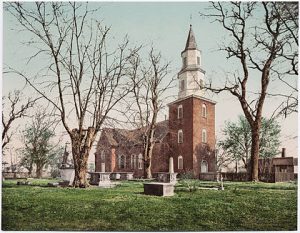
As stated above I am working on a mystery involving Thomas Jefferson that seems to conform to the continued template suggested at Oak Island and the Bruton Vault. In tandem with this, I have some specific pieces of literature and political documents that expose an amazing story of old world relics being hidden somewhere in Virginia, West Virginia, and North Carolina.
As I continue to document these same kinds of legends, they seem to pop up as the United States expanded westward into territory once the dominion of France or Spain. Naturally these countries also had a kind of masonic or chivalrous affinity for these kinds of hidden treasure or relic stories. Note that even though I refer to these as legends or myths, the inclusion of lost items of value is definitely suggested in some of these narratives.
It is also interesting to see how wealthy art collectors from different periods of history quested for specific items associated with some of these stories. For example, I see Hearst Castle in California and the Palace of the Legion of Honor in San Francisco as including some of the overtones of the Axis Mundi and the recordation of what may be considered lost history. Both of those locations include artwork and relics that may be combined to suggest an overall narrative. It is important to note that through time people have used what I term mystery school techniques meant to lead one on a kind of path of initiation in order to understand what is really going on. In the process, a great deal is learned about history that we all weren’t taught in high school or college. Part of the initiation involves becoming familiar with specific works of art and literature in addition to map reading and cartography.
Note also my thanks for including me in the land of the Arm Chair Treasure hunt and I am always keeping an eye on what is going on with you all! I do feel that some of these more popular treasure legends such as Oak Island have a great deal in common with things like the Forrest Fenn treasure. I think it is possible that Mr. Fenn is asking us all to consider some historical tid bits that have been overlooked and yet may reveal a great deal more in addition to the golden treasure he hid somewhere. Thanks Jenny!
.
Thank you, Cort! Incredible material and discoveries. My passion for treasure hunting first started with the term you use as the ‘Arcadian Mysteries’. I feel I am being drawn back to that extraordinary subject and mystery. As I delve back into that world, I would love to chat more with you on each of these fascinating connections you mention. So much is out there to learn…..
Thanks again for inspiring us all to look more into the ‘Mystery’ and the ‘History’ of the world! There is much to discover yet! Treasures abound!
Check out Cort’s YouTube Channel and his latest video:
.
.

